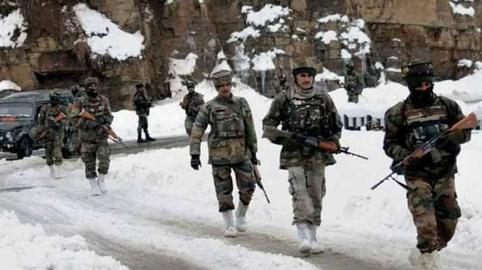Jianli Yang, a mathematician and human rights activist, survived China's Tiananmen Massacre in 1989, after which he left China for the United States. He returned in 2002 and was jailed between 2002 and 2007 for supporting the country's labor movement. He was intermittently held in solitary confinement for a total of 15 months – as detailed in a previous IranWire interview – and returned to the US after his release.
In a weekly series for IranWire, Jianli Yang analyses Chinese disinformation around the origin of coronavirus and its handling to date, and other recent affairs.
In early May Chinese soldiers occupied a stretch of the Pangong Tso lake, a key contested territory between China and India. Many articles have recently appeared in Chinese state media which strike a conciliatory tone towards India and stress the need to continue “dialogue” on the border question.
Other stories and editorials have warned India to not fall into the “Western camp”, clearly a vailed signal to US President Donald Trump who recently offered to mediate in on the ongoing stand-off. There is some irony to these propagandistic pieces, which are in effect produced by and for by the Chinese Communist Party - and have surfaced at a time of heightened criticism of China for its handling of the coronavirus outbreak.
Peace and Stability - Only After Military Goals Achieved
The first salvo was fired by China’s Foreign Ministry spokesperson, Zhao Lijian, on May 27, 2020. “We have been following the important consensus reached by the two leaders and strictly observing the agreements between the two countries," he said – apparently referring to the directions issued by the CCP leader Xi Jinping and Prime Minister Narendra Modi after their two informal summits, which asked the militaries of the two countries to take steps to maintain peace and tranquillity along the borders.
These remarks just came a day after Xi Jinping had ordered the military to scale up battle-preparedness in the area, visualising the worst case scenario and asked it to resolutely defend the country's sovereignty.
"We are committed to safeguarding our territorial sovereignty and security,” Zhao Lijian went on, “and to safeguarding peace and stability in the border areas. Now the China-India border area situation is overall stable and controllable".
This implied that China had achieved its goals militarily and now wanted talks to resolve the issue. China reportedly began occupying an area west of the line of actual control (LAC) in Pangong Tso on May 1, making it very clear that while both countries may well “have good border-related mechanisms and communication channels”, China was quite content with bypassing these and doing what it considered appropriate at the time.
India’s position was made clear in a media briefing in which the government countered the Chinese Communist Party (CCP)’s propagandistic claim that it was moving to block the supposed construction of a road across the LAC. The road being laid is in fact well within Indian territory in Ladakh, and the Chinese intention is clearly to offset any advantage to the road in military terms by inching closer to it.
India’s Ministry of External Affairs spokesperson said: "Any suggestion that Indian troops had undertaken activity across the LAC is not accurate. Indian troops are fully familiar with the alignment of the Line of Actual Control in the India-China border areas and abide by it scrupulously."
India's Relationship with US Criticized
The CCP would also like the world to believe that India is taking advantage of the current stand-off between the US and China by taking sides with the US, strengthening the already growing ties between the two states.
On June 6, the South China Morning Post quotes Sun Shihai, principal research fellow at the China Centre for South Asian Studies at Sichuan University in southwest China, saying that India had “taken advantage” of the prevailing tensions between Beijing and Washington.
Sun Shihai said: “India’s ruling Bharatiya Janata Party is advocating aggressive unilateralism when dealing with border problems involving China, Pakistan and Myanmar... there are signs and risks emerging that some Indian officials believe they can take advantage of the tensions between China and the US, as Washington is trying to bring India into its Indo-Pacific Strategy to contain a rising China.”
An editorial in the CCP’s mouthpiece the Global Times, dated June 6, had also warned India not to be “fooled” by Washington and added that China wanted “good-neighbourly” relations with India. The underlying warning to India not to fall foul of China is hypocritical as the argument is really about land-grab across what India perceives as the LAC.
This editorial raised the pitch, stating: “If the two countries face a showdown on the border issue, the entire Himalayan region and the Indian subcontinent will face instability. No external force can change this. Maintaining peace along border areas and friendly cooperation is in line with the two countries’ interests.”
This kind of diplomatic signalling preceded by military pressure indicates that the aggressive CCP is feeling jittery about national choices the Indian leadership has made in recent months. What is not acknowledged, though, is that these are decisions taken in the national interest. India’s diplomatic line is based on a realistic understanding of the current world order.
Furthermore, India’s objective in “mirror deployment” of forces in contested areas is only to lay down the parameters of engagement with China and not to generate conflict. But the CCP does not seem to want any conversation except on its terms. Its message must go out to the Chinese loudly and clearly.
The CCP is today facing global opprobrium for having set in motion the spread of coronavirus, first by blocking information about the virus itself and secondly by not imposing the lockdown in time.
Mounting Criticism Over Coronavirus Outbreak
An Associated Press analysis of domestic travel patterns using map location data from the Chinese tech giant Baidu shows that in the two weeks before Wuhan's lockdown, nearly 70 per cent of trips out of the central Chinese city were within Hubei province. Subsequently, another 14 per cent of trips went to neighbouring provinces of Henan, Hunan, Anhui and Jiangxi. Nearly 2 per cent slipped down to Guangdong province, the coastal manufacturing area across Hong Kong.
Travel patterns broadly indicate the early spread of the virus within China. The majority of confirmed cases and deaths occurred within Hubei province, followed by high numbers of cases in central China, with pockets in Chongqing, Shanghai and Beijing as well.
China did not enforce a lockdown till as late as 23 January 2020, demonstrating how keen it was to hide information about the virus from the rest of the world. For the CCP to now be peeved about the world blaming it for the spread of the virus is childish, because the facts on the ground now tell the only version of events that merits being told.
Adducing a reason for the CCP’s behaviour on the border with India in the midst of all is tricky. But the long-term trends clearly indicate the CCP has consciously used every opportunity to grab territory that is perceived by India to be its own. The only conclusion is that CCP used the opportunity provided by the pandemic and its own stand-off with the US to make further inroads into Indian territory.
Also in this series:
Missing Data, Mud-Slinging and “Miracle Cures”: Why Disinformation Is Bad For Your Health
Iranian Online Network Still Peddling Coronavirus Disinformation
Putin’s Domestic Problems Eclipse Russian Disinformation Campaigns
China's Campaign to Protect President Xi against Coronavirus Criticism
Chinese Embassies Work Overtime to Diffuse International Fury Over Coronavirus
Russia Bans Coronavirus "Fake News" and Slams US Over Press Freedom
China Blocks Investigations Amid Refusal to Shut Down Wet Markets
From Coronavirus to the Second World War: On the Frontlines of the Russian Disinformation Battle
Russia Blames West for Propaganda While Reporting Unlikely Number of Covid-19 Deaths
As Criticism of China Falters, Time for a NATO for Human Rights?
Guest Post From Russia: How do You Put the Brakes on a Fake News Machine?
Has China Really Given Assent to a Global Coronavirus Review?
Russian Disinformation Back to Targeting Ukraine as Putin Declares Covid-19 Peak has Passed
Will the Post-Coronavirus World Stand Up to China's Bullying Business Tactics?
Coronavirus: An Opportunity to Advance Russian Interests in Latin America
The Shi Zhengli Identification Criteria: How Do We Know Where Coronavirus First Emerged?
Covid-19 and Black Lives Matter Unrest Targeted by Russian Disinformation
visit the accountability section
In this section of Iran Wire, you can contact the officials and launch your campaign for various problems

























comments
China is like a fox. China also want to possess Indian Land at Ladakh. So, I wrote an article to reveal China's tactics in <a href="https://www.historypole.com/2020/06/Pangong-Lake-in-Ladakh.html">India China Pangong Lake Clash</a>